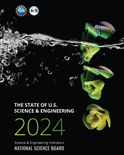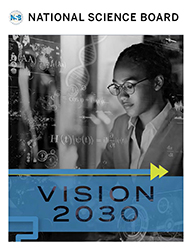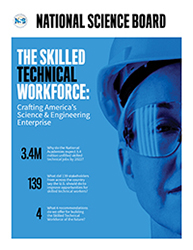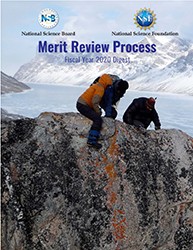News Release 12-130
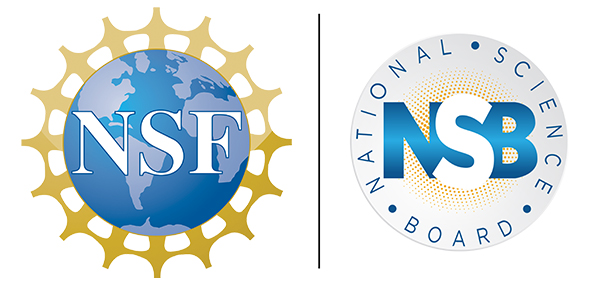
National Science Board Concerned About U.S. Innovation Capacity
Business R&D investment cut and shifted, public sector uncertainties
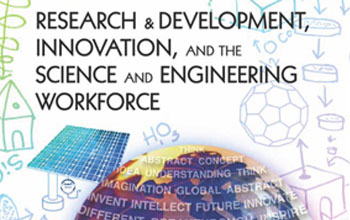
The cover of the National Science Board's recently released companion report. (Credit and Larger Version)
July 16, 2012
"Our nation's economic growth depends on our capacity to educate, innovate and build," says a new report released today by the National Science Board, the governing body of the National Science Foundation. But between 2008 and 2009, in the midst of the most recent recession, American businesses cut funding for research and development by nearly five percent, or $12 billion. The science board said these cuts coupled with government budget constraints at all levels are reasons for concern.
Private venture capital investment in select science and technology industries declined from $43 billion in 2000 to less than $10 billion in 2010. Private equity investments in certain S&T industries plummeted from nearly $60 billion in 2007 to less than $10 billion in 2008, but it has rebounded somewhat since then, reaching about $15 billion in 2010. The decline in private-sector investment was accompanied by a shift away from investment in crucial early stage start-ups, a more risky investment.
"Private-sector R&D investment is sensitive to economic trends," said Arthur K. Reilly, a former senior director for Strategic Technology Policy at Cisco Systems. "During recessions, it's not surprising that businesses would spend less. But the volatility also reflected shifts of private equity, venture capital and angel funding from early stage investment to the less risky late-stage investment," said Reilly, who led the development of the report.
During 2008-2009, when business investment dropped, the decline was partly, but temporarily, made up by increased federal R&D funding. But federal funding is more focused on fundamental, capacity-building research and private-sector funding on development, which is closer to the market. The federal government is the chief funder of basic research--funding 53 percent compared to the private sector's 22 percent. This basic research, much of it performed at National labs and research universities, generates the transformative knowledge base from which the private sector can draw.
The federal government also fosters business-funded R&D through tax credits, support for higher education and funding for programs such as the National Science Foundation's recently established Innovation Corps, which builds and strengthens public-private partnerships.
"A large, complex, and interdependent system of businesses, government and universities has made the U.S. the world's leader in science and technology," said Ray M. Bowen, who chairs the board's Committee on Science and Engineering Indicators. "Surveying the past decade, we see several troubling trends that, taken together, could have an impact on capacity to innovate in both the near and long term." Bowen is the president emeritus of Texas A&M University and a visiting distinguished professor at Rice University.
S&E workforce concerns
The board said it is also concerned about recent trends in the government's capacity to educate and train the future R&D workforce. State funding for major public research universities declined by an inflation-adjusted rate of 10 percent between 2002 and 2010, or by 20 percent on a per-student basis. Likewise, the federal government investment in academic R&D faces uncertainties due to future budget constraints.
"Human resources are key," said José-Marie Griffiths, a former science board member. "Today, the United States finds itself in a long-distance race to sustain its essential global advantage in science and engineering (S&E) human resources and our leadership in science and technology, even as attractive and competitive alternatives for education and jobs are increasing around the world for S&E talent.
"The federal and state governments play a leading role in training the next generation of scientists. Universities attract foreign talent and they conduct critical basic and applied research. Federal immigration and visa policies have a direct impact on our ability to attract and retain the type of science and engineering talent we need for economic growth here, " said Griffiths, the vice president for Academic Affairs at Bryant University.
"R&D-based innovation has long been a pillar of the U.S. economy, contributing importantly to the nation's wealth, employment, security, and general quality of life," the report said. "With growing international competition in high-technology industries, the need for continued and enhanced public efforts to strengthen national R&D is clear."
Innovative capacity still strong
Despite its concerns about the long-term health of the nation's innovation capacity, the Board indicated that there are reasons for optimism. Total U.S. R&D has grown nearly uninterrupted since 1953, with sizable increases from both the private sector and the federal government.
The private sector funded 62 percent and conducted 71 percent of all U.S. R&D in 2009. Notably, the private sector funded nearly 80 percent of development work, which is critical to bringing potential innovations to market.
In addition, while the annual growth of the science and engineering workforce has slowed to 1.4 percent during the last decade, it far exceeded the 0.2 percent growth in overall jobs. Unemployment is also lower among S&E degree holders and workers in S&E occupations than in other fields, and salaries tend to be higher.
The report released today--Research & Development, Innovation, and the Science and Engineering Workforce--is a companion report for Science and Engineering Indicators 2012, the biennial analysis that highlights trends and factors that have an impact on the nation's economy, competitiveness and innovation capacity.
For the report and more information, see the NSB website.
-NSF-
Media Contacts
Deborah Wing, NSF, (703) 292-5344, dwing@nsf.govBobbie Mixon, NSF, (703) 292-8070, bmixon@nsf.gov
Useful NSB Web Sites:
Home Page: http://www.nsf.gov/nsb
Media Contact: http://www.nsf.gov/staff/staff_bio.jsp?lan=nlymn&org=NSF
News: http://www.nsf.gov/nsb/news
Meetings: http://www.nsf.gov/nsb/meetings
Publications: http://www.nsf.gov/nsb/publications
Facebook: https://www.facebook.com/NationalScienceBoard
Twitter: Twitter: https://twitter.com/intent/user?screen_name=NSF_NSB
YouTube: https://www.youtube.com/channel/UCkrHRzuGSrPp2haQs0T_Pww
To view PDF documents, please download Adobe Acrobat Reader.
